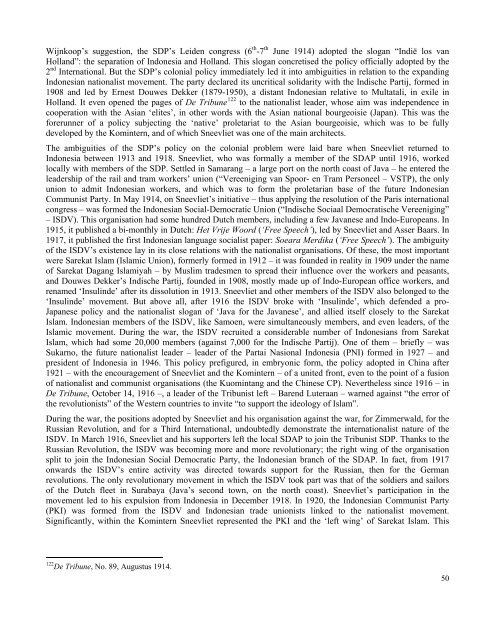The German-Dutch Communist Left - Libcom
The German-Dutch Communist Left - Libcom
The German-Dutch Communist Left - Libcom
You also want an ePaper? Increase the reach of your titles
YUMPU automatically turns print PDFs into web optimized ePapers that Google loves.
Wijnkoop’s suggestion, the SDP’s Leiden congress (6 th -7 th June 1914) adopted the slogan “Indië los van<br />
Holland”: the separation of Indonesia and Holland. This slogan concretised the policy officially adopted by the<br />
2 nd International. But the SDP’s colonial policy immediately led it into ambiguities in relation to the expanding<br />
Indonesian nationalist movement. <strong>The</strong> party declared its uncritical solidarity with the Indische Partij, formed in<br />
1908 and led by Ernest Douwes Dekker (1879-1950), a distant Indonesian relative to Multatali, in exile in<br />
Holland. It even opened the pages of De Tribune 122 to the nationalist leader, whose aim was independence in<br />
cooperation with the Asian ‘elites’, in other words with the Asian national bourgeoisie (Japan). This was the<br />
forerunner of a policy subjecting the ‘native’ proletariat to the Asian bourgeoisie, which was to be fully<br />
developed by the Komintern, and of which Sneevliet was one of the main architects.<br />
<strong>The</strong> ambiguities of the SDP’s policy on the colonial problem were laid bare when Sneevliet returned to<br />
Indonesia between 1913 and 1918. Sneevliet, who was formally a member of the SDAP until 1916, worked<br />
locally with members of the SDP. Settled in Samarang – a large port on the north coast of Java – he entered the<br />
leadership of the rail and tram workers’ union (“Vereeniging van Spoor- en Tram Personeel – VSTP), the only<br />
union to admit Indonesian workers, and which was to form the proletarian base of the future Indonesian<br />
<strong>Communist</strong> Party. In May 1914, on Sneevliet’s initiative – thus applying the resolution of the Paris international<br />
congress – was formed the Indonesian Social-Democratic Union (“Indische Sociaal Democratische Vereeniging”<br />
– ISDV). This organisation had some hundred <strong>Dutch</strong> members, including a few Javanese and Indo-Europeans. In<br />
1915, it published a bi-monthly in <strong>Dutch</strong>: Het Vrije Woord (‘Free Speech’), led by Sneevliet and Asser Baars. In<br />
1917, it published the first Indonesian language socialist paper: Soeara Merdika (‘Free Speech’). <strong>The</strong> ambiguity<br />
of the ISDV’s existence lay in its close relations with the nationalist organisations. Of these, the most important<br />
were Sarekat Islam (Islamic Union), formerly formed in 1912 – it was founded in reality in 1909 under the name<br />
of Sarekat Dagang Islamiyah – by Muslim tradesmen to spread their influence over the workers and peasants,<br />
and Douwes Dekker’s Indische Partij, founded in 1908, mostly made up of Indo-European office workers, and<br />
renamed ‘Insulinde’ after its dissolution in 1913. Sneevliet and other members of the ISDV also belonged to the<br />
‘Insulinde’ movement. But above all, after 1916 the ISDV broke with ‘Insulinde’, which defended a pro-<br />
Japanese policy and the nationalist slogan of ‘Java for the Javanese’, and allied itself closely to the Sarekat<br />
Islam. Indonesian members of the ISDV, like Samoen, were simultaneously members, and even leaders, of the<br />
Islamic movement. During the war, the ISDV recruited a considerable number of Indonesians from Sarekat<br />
Islam, which had some 20,000 members (against 7,000 for the Indische Partij). One of them – briefly – was<br />
Sukarno, the future nationalist leader – leader of the Partai Nasional Indonesia (PNI) formed in 1927 – and<br />
president of Indonesia in 1946. This policy prefigured, in embryonic form, the policy adopted in China after<br />
1921 – with the encouragement of Sneevliet and the Komintern – of a united front, even to the point of a fusion<br />
of nationalist and communist organisations (the Kuomintang and the Chinese CP). Nevertheless since 1916 – in<br />
De Tribune, October 14, 1916 –, a leader of the Tribunist left – Barend Luteraan – warned against “the error of<br />
the revolutionists” of the Western countries to invite “to support the ideology of Islam”.<br />
During the war, the positions adopted by Sneevliet and his organisation against the war, for Zimmerwald, for the<br />
Russian Revolution, and for a Third International, undoubtedly demonstrate the internationalist nature of the<br />
ISDV. In March 1916, Sneevliet and his supporters left the local SDAP to join the Tribunist SDP. Thanks to the<br />
Russian Revolution, the ISDV was becoming more and more revolutionary; the right wing of the organisation<br />
split to join the Indonesian Social Democratic Party, the Indonesian branch of the SDAP. In fact, from 1917<br />
onwards the ISDV’s entire activity was directed towards support for the Russian, then for the <strong>German</strong><br />
revolutions. <strong>The</strong> only revolutionary movement in which the ISDV took part was that of the soldiers and sailors<br />
of the <strong>Dutch</strong> fleet in Surabaya (Java’s second town, on the north coast). Sneevliet’s participation in the<br />
movement led to his expulsion from Indonesia in December 1918. In 1920, the Indonesian <strong>Communist</strong> Party<br />
(PKI) was formed from the ISDV and Indonesian trade unionists linked to the nationalist movement.<br />
Significantly, within the Komintern Sneevliet represented the PKI and the ‘left wing’ of Sarekat Islam. This<br />
122 De Tribune, No. 89, Augustus 1914.<br />
50
















